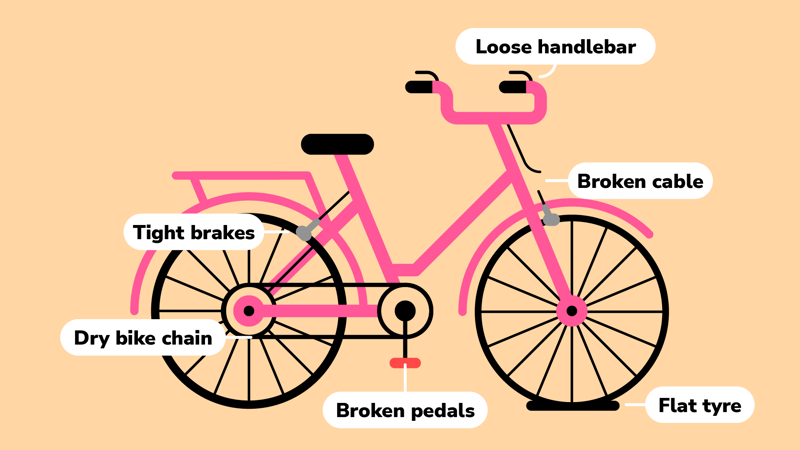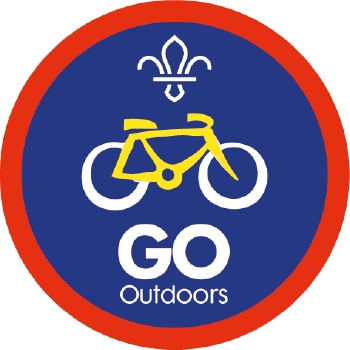
Repair shop runaround
You’ll need
- Access to water
- Bikes
- Access to internet (optional)
- Blindfold (optional)
- Specific equipment for each base (see instructions)
Before you begin
- Have anyone who owns or has access to a bicycle bring it along to the session. Those with repair kits should also bring these along with them. There’s a reasonable chance that lots of people won’t have access to a bicycle, so you may need to contact local cycling clubs, repair shops and rental services to see if they can help.
- Invite along some parents, carers and Young Leaders to support the session. If they have an interest in cycling and bicycle maintenance, even better!
- If you’re new to bicycle maintenance, have a look at these downloadable guides.
- Use this maintenance activity to prepare for a group bike ride. Set up activity bases covering all the essential maintenance and repairs needed for normal road bicycles. Try to spread these out and use outdoor space too, if you can.
- Don't forget to have a look at our cycling guidance too.
Bear in mind that anyone working towards their Scouts Cyclist Activity Badge needs to cover: checking and adjusting brakes, checking and adjusting gear-change, height-adjusting the seats and handlebars, removing a wheel and locating and repairing a puncture, checking and adjusting a cycle helmet and maintaining a set of lights.
Make it shine
You will need
- Cleaning fluid
- Brush
- Hose or bottle
- Grease or lubricant
- Old toothbrush
- Rag
- Chamois leather
- Polish
Full instructions for this activity can be found in Bike update.
- Make sure each group or individual with a bike has the necessary cleaning materials next to their bike.
- Explain that you’re going to learn how to maintain your bike, which, firstly, means cleaning it.
- The person leading the session should complete the following steps, making sure everyone can see and copy them on their own bikes. Alternatively, give a copy of the clean bike sheet to each group or individual so they can work through it independently.
- Start cleaning at the top and work your way down, not forgetting under the seat.
- Use a brush to reach places in-between gears and spokes, and to remove dried mud.
- Use bike cleaner for dried-on mud.
- A garden hose or sports water bottle can help to rinse the bike.
- Don’t worry about rinsing brakes or gears. These need a little grease to keep them moving.
- Use an old toothbrush to apply degreaser to intricate parts such as gear cassettes, jockey wheels, chain rings and the chain.
- After washing, dry the bike off carefully with a soft, clean rag.
- Put some lubricant on the chain after you’ve finished cleaning the bike to keep the chain running smoothly.
No fuss adjustments
You will need
- Helmets
- Allen keys
- For a snug cycle helmet, everyone should check that:
-
- There’s no more than two finger widths between the eyebrows and the front of the helmet.
- The chin strap is tight enough (two fingers should fit between the strap and the chin).
- The straps form a ‘V’ around the ears on both sides.
- Bear in mind that the same helmet won’t fit different people the same way. Readjust it for those with different hair, headscarves or head sizes.
- Test the helmet by having the person wearing it shake their head. If the helmet doesn’t wobble, it’s good to go!
- For the correct seat and handlebar height, have a person sit or stand upright over the bicycle with their feet on the ground. Keep the bicycle standing upright.
- Check the seat height by having the rider sit on the saddle and put their heel on a pedal. Pedal it back to the six o’clock position (vertical).
-
- If the knee of that leg is not completely straight, then the seat needs adjusting.
- A bent knee means that the saddle needs raising, a small amount at a time.
- The heel losing contact with the pedal means that the saddle needs lowering, a small amount at a time.
- Check the handlebar height by having the rider sit on the saddle and put their feet on the pedals and hands on the bars. A couple of others should hold them upright. Someone else should check where the handlebars line up with the rider.
-
- If they’re below the belly button, they need to be raised to maintain balance and control.
- If they’re well above the belly button, they need to be lowered.
- Adjust the bars a small amount at a time.
- Check the brakes by pulling on each lever one after the other. For each lever pulled, carefully rock the bike backwards and forwards.
-
- With the front wheel brake pulled, the front wheel should lock and the back wheel should lift off the ground.
- With the back wheel brake pulled, the back wheel should lock and skid as you move forwards.
- Brakes are very important when you’re out on a ride, so if the wheels don’t lock as they should, you should adjust the brakes carefully by closely following these instructions.
- Gears can only be checked while you’re already riding. Don’t change gears while the bicycle is stationary, or the chain might fall off. If the gears or chain aren’t working properly, adjust the gears with these instructions.
Puncture patchers
You will need
- Puncture repair kit
- Spanner
- Spare inner tube
- Bike pump
- Tyre levers
- Tyre pressure gauge
To fix a puncture, follow the wheel-y easy instructions set out in Reinvent the wheel to remove front and back wheels and locate the puncture. If no-one has a puncture (this is likely), run through the steps anyway to demonstrate what to do when one happens.
- Carefully feel inside the tyre for where the damage may have been caused. If something sharp is sticking out, remove it.
- Sand around the hole in the inner tube until it’s roughened a little. Making sure the inner tube is dry, stick on a patch from the kit.
- Pump a small amount of air into the inner tube then tuck it back inside the tyre, starting opposite the valve, and then reset the tyre.
- Inflate the inner tube to the manufacturer’s specification. Re-attach the wheel, checking that no part of the tube is trapped under the tyre.
Illumination station
You will need
- Detachable front and rear lights for seeing in the dark, being seen and for off-roading
- Check that all of the bicycle lights are working.
- Have everyone practice mounting and detaching front and rear lights to a bike. Make sure they’re the right way around! Many modern lights can easily be attached and detached, but if you have a variety, there could be some different steps to master.
- Talk about the position of the lights and why they’re fitted where they are. See if anyone can think of any reasons why we don’t wear head-torches when riding a bicycle, and only mount lights at the level of the bicycle frame.
- With lights mounted, bring the bikes somewhere dark, either outside or in a dark room. Test the reach of the beams by placing the bikes facing forwards at one end of the activity area and switching the front lights on, then placing the bikes facing backwards and switching the back lights on.
- Talk about the difference between the following groups of lights:
-
- ‘Be seen lights’: These are front and rear lights for use on the road, which help you be seen by other road users in reasonably well-lit areas. Often, these lights flash, so that they’re more noticeable. These lights can be attached to bikes or the body, as they don’t produce enough light to dazzle anyone (often between 500-700 lumens). Talk about why it’s important to be seen by other road users, for their safety and yours.
- ‘See with lights’: These are front lights for use on the road, which help you see the way ahead. These are much brighter than ‘be seen lights,’ as they need to show changes in the terrain and obstacles, often in reduced light.
- ‘Off-road lights’: These are front lights for use off-road, which help you see the way ahead. These are usually even brighter than most road lights, as there’s often more difficult terrain and more obstacles off-road, so you need to be able to see more. Off-road trails can contain narrow tracks, covered (woodland) trails and sharp bends, and are very often unlit.
Reflection
Looking after our bicycles is one way we can be more independent, responsible and sustainable. It’s also cheaper than taking your bike to a repair shop. Why is it beneficial to know how to fix your bicycle by yourself? Remember, there isn’t likely to always be a repair shop nearby on the route you’re riding.
Adjusting the features of a bicycle is important for energy-efficient riding. Why might it be a good idea to always check the seat and handlebar height before starting your ride? Over time, these could slip and subtly alter, or they could shift if your bike falls over. Give your machine a regular once-over, to check everything’s suited to you and the way you ride.
Safety
All activities must be safely managed. You must complete a thorough risk assessment and take appropriate steps to reduce risk. Use the safety checklist to help you plan and risk assess your activity. Always get approval for the activity, and have suitable supervision and an InTouch process.
- Chemicals
This task involves the use of potentially harmful fluids or chemicals. Make sure you follow all relevant safety guidance. Make sure you dispose of them appropriately too, in line with safety guidance.
- Cycle and wheeled activities
Use appropriate protective equipment. You must wear helmets. Wear elbow and knee pads as defined by your risk assessment.
Have cycling supremos in your group run activity bases as part of this activity. They’ll need some time to prepare, so let them know in a previous session what you’ll need from them and whether they need to bring any equipment along. Challenge your experts to demonstrate their knowledge in more ways than simply talking. They could perform a role-play scenario, prepare a video tutorial or demonstrate their skills by performing a maintenance task blindfolded!
All bases will still need to be supervised to make sure all maintenance and repair is done safely and that all equipment is fit for purpose.
Consider how maintenance and repair tasks can be completed safely and to the same standard left-handed or with limited motor skills.
All Scout activities should be inclusive and accessible.
Include the skills picked up in this activity in your preparations for all future cycling trips. If anyone wants to learn more about bicycle lights and why they need to be used responsibly, check out this article. For help with the units used to measure light output (like ‘lumens,’ ‘candelas’ and ‘watts’) see here.
This activity encourages independence, as group members take responsibility for their belongings and personal safety, while carefully considering the safety of other road users.
